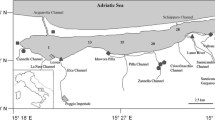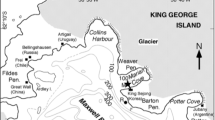Abstract
A long-term study (monthly sampling, 1992 to 2007) was conducted in the surf zone of Cassino Beach, Southern Brazil, in order to detect possible natural and/or anthropogenic disturbances. Surface water temperature (6–29°C) was the only parameter with predictable seasonal variation; salinity (14–38) was inversely related to rainfall (3.1–485.2 mm month−1) and low values followed extreme precipitation periods in 1997/1998 and 2002/2003 (El Niño years). Asterionellopsis glacialis and chlorophyll a presented high concentrations and peak frequency until 1998, when an intense mud deposition occurred with concomitant extreme rainfall. It affected the surf zone and beach, changing the hydrology and dissolved inorganic nutrient availability. Six phytoplankton species groups were recognized with distinct responses to this mud deposition. We conclude that large-scale climatic changes, like El Niño Southern Oscillation, in conjunction with human activities significantly altered the phytoplankton ecology of the highly dynamic Cassino Beach surf zone.







Similar content being viewed by others
References
Abreu, P.C., C. Hartmann, and C. Odebrecht. 1995. Nutrient rich salt-water and its influence on the phytoplankton of the Patos Lagoon estuary. Estuarine Coastal and Shelf Science 40: 219–229. doi:10.1016/S0272-7714(05)80006-X.
Abreu, P.C., L.R. Rörig, V.M. Garcia, C. Odebrecht, and B.B. Biddanda. 2003. Decoupling between bacteria and surf-zone diatom Asterionellopsis glacialis (Castracane) in Cassino Beach, Brazil. Aquatic Microbial Ecology 32: 219–228. doi:10.3354/ame032219.
Abreu, P.C., M. Bergesch, L.A. Proença, C.E. Garcia, and C. Odebrecht. 2009. Short-and long-term chlorophyll a variability in the shallow microtidal Patos Lagoon estuary, Southern Brazil. Estuaries and Coasts doi:10.1007/S12237-009-9181-9.
Anil, A.C., S. Mitbavkar, M.S. D’Silva, S. Hegde, P.M. D’Costa, S.S. Meher, and D. Banerjee. 2007. Effect of ageing on survival of benthic diatom propagules. Journal of Experimental marine Biology and Ecology 343(1): 37–43. doi:10.1016/j.jembe.2006.11.006.
Becking, L.B., C.F. Tolman, H.C. McMillin, F. Field, and T. Hashimoto. 1927. Preliminary statement regarding the diatom “epidemics” at Copalis Beach, Washington and an analysis of diatom oil. Economic Geology 22: 356–368. doi:10.2113/gsecongeo.22.4.356.
Bergesch, M., C. Odebrecht, and Ø. Moestrup. 2008a. Nanoflagellates from coastal waters in the Southwestern Atlantic (32° S). Botanica Marina 51: 35–50. doi:10.1515/BOT.2008.003.
Bergesch, M., C. Odebrecht, and Ø. Moestrup. 2008b. Choanoflagellates from coastal waters in the Southwestern Atlantic (32° S) with description of a new species. Biota Neotropica 8(4): 87–92.
Bergesch, M., C. Odebrecht, and M. Garcia. 2009. Diversity and morphology of Skeletonema species in southern Brazil. Journal of Phycology (in press).
Biddanda, B., P.C. Abreu, and C. Odebrecht. 2006. Algal blooms and bacterial interactions. In Algal Blooms, Analogues of Blooms and Applications, ed. D.V. Subba Rao, 163–188. Enfield: Science.
Borzone, C., and N.M. Gianuca. 1990. A zonação infralitoral em praias arenosas expostas. Publicação da Academia de Ciências do Estado de São Paulo 71(3): 280–295.
Brown, A.C., and A. McLachlan. 1990. Ecology of Sandy Shores. Amsterdam: Elsevier.
Calliari, L.J. 1997. Geomorphological setting. In Subtropical Convergence Environments: The Coast and Sea in the Southwestern Atlantic, ed. U. Seeliger, C. Odebrecht, and J.P. Castello, 91–94. Berlin: Springer.
Calliari, L.J., N.S. Speranski, M. Torronteguy, and M.B. Oliveira. 2000. The mud banks of Cassino Beach, Southern Brazil: Characteristics, processes and effects. Journal of Coastal Research ICS 2000 Proceedings 1–9.
Calliari, L.J., K.T. Holland, P.S. Pereira, R.M.C. Guedes, and R.E. Santo. 2007. The influence of mud on the inner shelf, shoreface, beach and surf-zone morphodynamics, Cassino, Southern Brazil. Proceedings of Coastal Sediments 2007. New Orleáns, vol. 2, pp 1455–1465
Campbell, E.E., and G.C. Bate. 1998. Tide-induced pulsing of nutrient discharge from an unconfined aquifer into an Anaulus australis-dominated surf-zone. Water SA 24(4): 365–370.
Cunha, A.M., and O. Fonseca. 1918. O microplancton das costas meridionaes do Brasil. Memórias do Instituto Oswaldo Cruz 10: 99–103.
Dugdale, R.C., B.H. Jones Jr., and J.J. MacIsaac. 1981. Adaptation of nutrient assimilation. In Physiological Bases of Phytoplankton Ecology, ed. T. Platt, 234–250. Ottawa: Canadian Bulletins of Fisheries and Aquatic Sciences 210.
Faria, J.G., and A.M. Cunha. 1917. Estudos sobre o microplancton da baía do Rio de Janeiro e suas imediações. Memórias do Instituto Oswaldo Cruz 9: 68–93.
Frenguelli, J. 1928. Diatomeas del Océano Atlántico frente a Mar del Plata. Anales del Museu Nacional de Historia Natural 34: 497–571. 21 plates.
Garcia, V.M.T., and N.M. Gianuca. 1997. The beach and surf-zone. In Subtropical Convergence Environments: The Coast and Sea in the Southwestern Atlantic, ed. U. Seeliger, C. Odebrecht, and J.P. Castello, 166–170. Berlin: Springer.
Garcia, M., and C. Odebrecht. 2008. Morfologia e ecologia de diatomácea planctônica Palmerina hardmaniana (Greville) Hasle no Sul do Brasil. Biota Neotropica 8(2): 85–90. doi:10.1590/S1676-06032008000200009.
Garcia, M., and C. Odebrecht. 2009a. Morphology and ecology of rarely recorded Thalassiosira Cleve (Bacillariophyta) species in Brazilian coastal water. Brazilian Journal of Biology (in press).
Garcia, M., and C. Odebrecht. 2009b. Chave dicotômica ilustrada para a identificação de espécies de Thalassiosira Cleve (diatomácea) no estuário da Lagoa dos Patos e área costeira adjacente (Rio Grande do Sul, Brasil). Biota Neotropica (in press).
Gayoso, A.M., and V.H. Muglia. 1991. Blooms of the surf-zone diatom Gonioceros armatum (Bacillariophyceae) on the South Atlantic coast (Argentina). Diatom Research 6: 247–253.
Grimm, A.M., S.E.T. Ferraz, and J. Gomes. 1998. Precipitation anomalies in southern Brazil associated with El Niño and La Niña events. Journal of Climate 11: 2863–2880. doi:10.1175/1520-0442(1998)011<2863:PAISBA>2.0.CO;2.
Hair, J.F., R.E. Anderson, R.L. Tatham, and W.C. Black. 2005. Análise Multivariada de Dados, 593. Porto Alegre: Bookman.
Hallegraeff, G., and S. Gollash. 2006. Anthropogenic introductions of microalgae. In Ecology of Harmful Algae, ed. E. Granéli and J.T. Turner, 379–390. Berlin: Springer.
Hasle, G. 1978. Using the inverted microscope. In Phytoplankton Manual, Monographs on Oceanographic Methodology 6, ed. A. Sournia, 191–196. Paris: UNESCO.
Hewson, I., J.M. O’Neil, and E. Abal. 2001. A low-latitude bloom of the surf-zone diatom, Anaulus australis (Centrales, Bacillariophyta) on the coast of Southern Queensland (Australia). Journal of Plankton Research 23: 1233–1236. doi:10.1093/plankt/23.11.1233.
Lewin, J., and R.E. Norris. 1970. Surf-zone diatoms of the coasts of Washington and New Zealand (Chaetoceros armatum T. West and Asterionella spp.). Phycologia 9: 143–149.
Lewin, J., C.T. Schaefer, and D.F. Winter. 1989. Surf-zone ecology and dynamics. In Coastal Oceanography of Washington and Oregon. Elsevier Oceanography Series, vol. 47, ed. M.R. Landry and B.M. Hickey, 567–594. Amsterdam: Elsevier.
Macedo, C.X. 2007. Dinâmica temporal de microalgas de zona de arrebentação na Praia de Navegantes, SC. M.Sc. thesis, Federal University of Paraná, Curitiba, Brazil. 93 pp.
Mantel, N. 1967. The detection of disease clustering and a generalized regression approach. Cancer Research 27: 209–220.
Martin, J.L., and M. LeGresley. 2008. New phytoplankton species in the Bay of Fundy since 1995. ICES Journal of Marine Science 65: 759–764.
McLachlan, A., and P. Hesp. 1984. Surf-zone diatom accumulations on the Australian coast. Search 15: 230–231.
Niencheski, L.F.H., H.L. Windom, W.S. Moore, and R.A. Jahnke. 2007. Submarine groundwater discharge of nutrients to the ocean along a coastal lagoon barrier, Southern Brazil. Marine Chemistry 106: 546–561. doi:10.1016/j.marchem.2007.06.004.
Odebrecht, C., A.Z. Segatto, and C.A. Freitas. 1995a. Surf-zone chlorophyll a variability at Cassino Beach, Southern Brazil. Estuarine Coastal and Shelf Science 41: 81–90. doi:10.1006/ecss.1995.0054.
Odebrecht, C., L.R. Rörig, V.M.T. Garcia, and P.C. Abreu. 1995b. Shellfish mortality and a red tide event in southern Brazil. In Harmful Marine Algal Blooms, ed. P. Lassus, G. Arzul, E. Erard, P. Gentien, and C. Marcaillou, 213–218. Paris: Lavoisier Science.
Odebrecht, C., P.C. Abreu, C.C. Fujita, and M. Bergesch. 2003. The impact of mud deposition on the long term variability of the surf-zone diatom Asterionellopsis glacialis (Castracane) Round. Journal of Coastal Research 35: 493–498.
Reynaldi, S. 2000. Efeito da diatomácea de zona de arrebentação Asterionellopsis glacialis (Castracane) Round, sobre o crescimento bacteriano na Praia do Cassino, RS, Brasil. M.Sc. thesis, Federal University of Rio Grande, Rio Grande, Brazil.
Romesburg, H.C. 1984. Cluster Analysis for Researchers, 334. Belmont: Lifetime Learning.
Rörig, L.R., C. Resgalla Jr., P.R. Pezzuto, E. Alves, and F. Morelli. 1997. Análise ecológica de um processo de acumulação da diatomácea Anaulus sp. na zona de arrebentação da Praia de Navegantes (Santa Catarina), Brasil. Oecologia Brasiliensis 3: 29–43.
Rörig, L.R., and V.M.T. Garcia. 2003. Accumulations of the surf-zone diatom Asterionellopsis glacialis (Castracane) Round in Cassino Beach, Southern Brazil, and its relationship with environmental factors. Journal of Coastal Research 19: 167–177.
Rörig, L.R., T.C.M. Almeida, and V.M.T. Garcia. 2006. Structure and succession of the surf-zone phytoplankton in Cassino Beach, Southern Brazil. Journal of Coastal Research 39: 1246–1250.
Schaefer, C.T., and J. Lewin. 1984. Persistent blooms of surf-zone diatoms along the Pacific coast, USA. IV. Diatom productivity and its relation to standing stock. Marine Biology 83: 205–217. doi:10.1007/BF00394729.
Seeliger, U. 2003. Response of southern Brazilian coastal foredunes to natural and human-induced disturbance. Journal of Coastal Research 35: 51–55.
Seeliger, U., and C.S.B. Costa. 2002. The Patos-Mirin basins, lagoons and estuary, South Brazil: Natural and human forcing factors. In South American basins: LOICZ global change assessment and synthesis of river catchment—Coastal sea interaction and human dimensions, eds. L.D. Lacerda, H.H. Kremer, B. Kjerfve, W. Salomons, J.I. Marshall Crossland and C.J. Crossland, 105-112. Texel: LOICZ Reports and Studies 21:ii + 212pp.
Seeliger, U., C.V. Cordazzo, C.P.L. Oliveira, and M. Seeliger. 2000. Long-term changes of coastal foredunes in the Southwest Atlantic. Journal of Coastal Research 16(4): 1068–1072.
Short, A.D., and L.D. Wright. 1983. Physical variability of sandy beaches. In Sandy Beaches as Ecosystems, ed. A. McLachlan and T. Erasmus, 133–144. Hingham: W Junk.
Snedecor, G., and W. Cochran. 1980. Statistical Methods. Ames: Iowa State University Press. 507 pp.
Soares, I.D., and O.O. Möller. 2001. Low-frequency currents and water mass spatial distribution on the southern Brazilian shelf. Continental Shelf Research 21: 1785–1814. doi:10.1016/S0278-4343(01)00024-3.
Strickland, J.D.H., and T.R. Parsons. 1972. A Practical Handbook of Seawater Analysis. Ottawa: Fisheries Research Board of Canada.
Talbot, M.M.B., and G.C. Bate. 1987. Rip current characteristics and their role in the exchange of water and surf diatoms between the surf-zone and nearshore. Estuarine Coastal and Shelf Science 25: 707–720. doi:10.1016/0272-7714(87)90017-5.
Talbot, M.M.B., and G.C. Bate. 1988. The response of diatom populations to environmental conditions, changes in the extent of the planktonic fraction and surface patch activity. Botanica Marina 31: 109–118.
Talbot, M.M.B., and G.C. Bate. 1989. Beach morphodynamics and surf-zone diatom populations. Journal of Experimental Marine Biology and Ecology 129: 231–241. doi:10.1016/0022-0981(89)90105-6.
Talbot, M.M.B., G.C. Bate, and E.E. Campbell. 1990. A review of the ecology of surf-zone diatoms, with special reference to Anaulus australis. Oceanography and Marine Biology, an Annual Review 28: 155–175.
UNESCO. 1983. Chemical Methods for Use in Marine Environmental Monitoring. Manual and Guides 12. Paris: Intergovernmental Oceanographic Commission.
Villac, M.C., and V.A.P. Noronha. 2008. The surf-zone phytoplankton of the state of São Paulo, Brazil. I. Trends in space-time distribution with emphasis on Asterionellopsis glacialis and Anaulus australis (Bacillariophyceae). Nova Hedwigia, Beiheft 133: 115–129.
Villwock, J.A., and L.R.S. Martins. 1972. Depósitos lamíticos de pós-praia, Cassino, RS. Pesquisas, Porto Alegre 1: 69–85.
Vooren, C.M. 1997. Sea and shore birds. In Subtropical Convergence Environments: The Coast and Sea in the Southwestern Atlantic, ed. U. Seeliger, C. Odebrecht, and J.P. Castello, 154–159. Berlin: Springer.
Welschmeyer, N.A. 1984. Fluorometric analysis of chlorophyll a in the presence of chlorophyll b and phaeopigments. Limnology and Oceanography 39: 1985–1992.
Acknowledgments
We would like to thank Mr. Valnei Rodrigues and students for technical support in the field and laboratory all these years and to Dr. Juliano Marangoni for statistical consultancy and analysis. We are also grateful to the anonymous reviewers for many suggestions, which greatly improved the final manuscript. The study (1998–2007) was conducted in the framework of the Long-Term Ecological Research funded by CNPq-PELD-FURG project no. 520188/98-5. C. Odebrecht and P.C. Abreu are research fellows of CNPq-Ministry of Sciences, Brazil.
Author information
Authors and Affiliations
Corresponding author
Rights and permissions
About this article
Cite this article
Odebrecht, C., Bergesch, M., Rörig, L.R. et al. Phytoplankton Interannual Variability at Cassino Beach, Southern Brazil (1992–2007), with Emphasis on the Surf Zone Diatom Asterionellopsis glacialis . Estuaries and Coasts 33, 570–583 (2010). https://doi.org/10.1007/s12237-009-9176-6
Received:
Revised:
Accepted:
Published:
Issue Date:
DOI: https://doi.org/10.1007/s12237-009-9176-6




